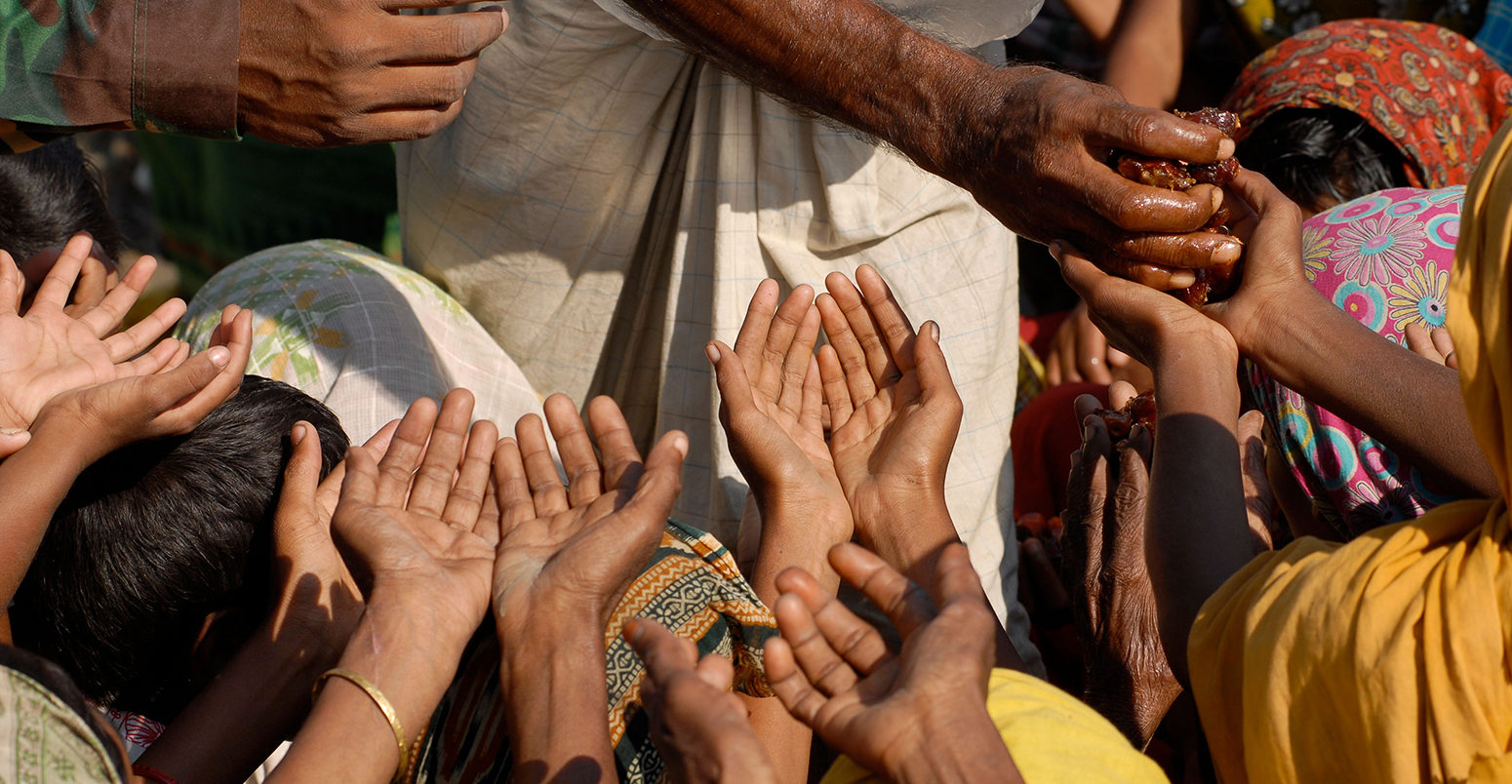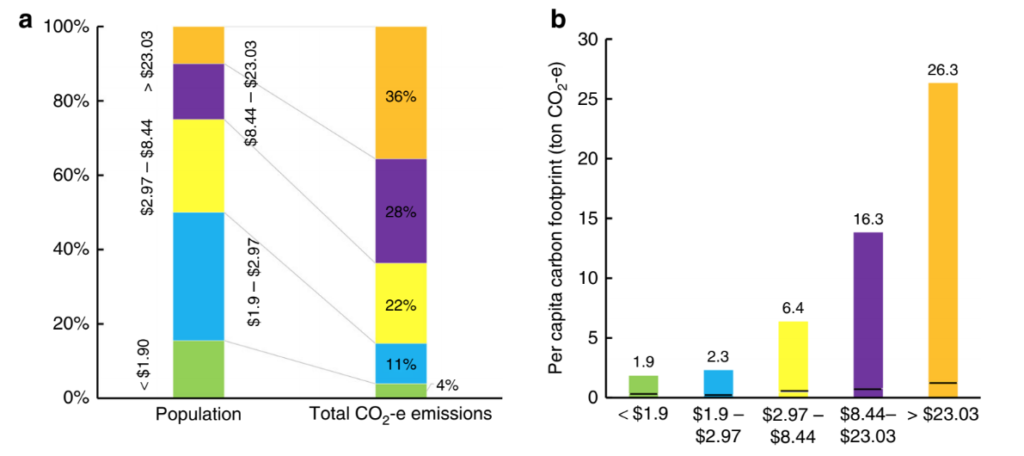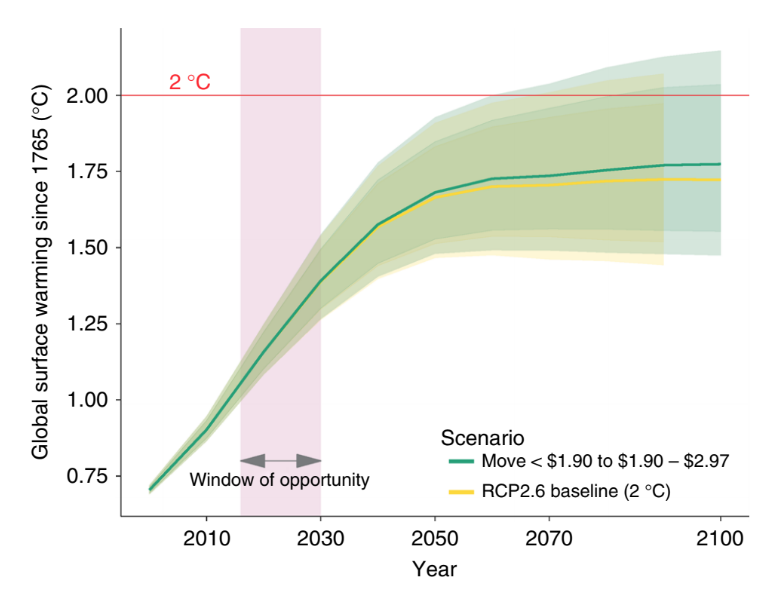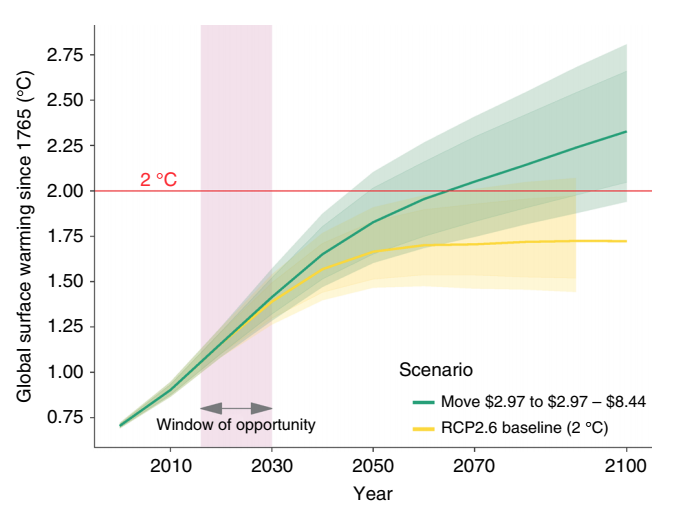
Study: Ending extreme poverty and limiting warming to 2C still possible
Daisy Dunne
10.24.17Daisy Dunne
24.10.2017 | 4:00pmBringing “extreme” poverty to an end will not jeopardise the chances of limiting global warming to 2C above pre-industrial levels, a new study says.
Pulling the 770 million people around the world out of extreme poverty – which is defined as living on less than $1.90 a day – would add a mere 0.05C to global temperatures by 2100, the research shows.
However, eradicating poverty entirely by moving the world’s poorest into a “global middle class” income group, which earns a modest $2.97-8.44 a day, could add 0.6C to global temperatures by 2100.
In order to end all forms of poverty without driving up global temperatures, world leaders will need to ramp up climate mitigation efforts by 27%, the lead author tells Carbon Brief.
‘Climate-development conflict’
Ending extreme poverty for “all people everywhere” is the first of the United Nation’s Sustainable Development Goals, an internationally-agreed set of targets aimed to improve the global standard of living by 2030.
However, putting an end to extreme poverty could bring additional challenges to meeting the long-term goals of the Paris Agreement, which aims to limit global temperature rise to “well below” 2C.
This is because raising the quality of life of the world’s poorest would mean using more of the planet’s resources – such as food and energy – driving up carbon emissions that contribute to global warming.
This paradox is known as the “climate-development conflict”, explains Prof Klaus Hubacek, a researcher at the University of Maryland and lead author of the new research published in Nature Communications.
In his research, he aimed to quantify the total “cost”, in terms of carbon emissions, of ending extreme poverty. He tells Carbon Brief:
“Eradicating extreme poverty does not jeopardise the climate target even in the absence of climate policies and with current technologies.”
Carbon inequality
To calculate the cost of eradicating extreme poverty, the researchers first set about estimating the carbon footprints of the world’s poorest and richest people.
For each carbon footprint, researchers considered both direct carbon emissions – from the consumption of food, heating and cooling of homes and the use of transport – and indirect carbon emissions – from the production of household goods and services. They then combined this with expenditure data from the World Bank’s Global Consumption Database.
Food makes up the largest proportion of the carbon footprint of those living in extreme poverty, Hubacek explains:
“The food-related carbon footprint is close to 60% of the total footprint for the extreme poverty group. It’s mainly food, shelter, clothes. There’s nothing much left for anything else when your expenditure is $1.90 a day in purchasing power parities (PPP).”
The chart below (left) shows the respective carbon footprints of the world’s rich and poor. The left column shows how the world’s population can be split into different income groups, including those living on: less than $1.90 a day (green); between $1.90 and $2.97 a day (blue); between $2.97 and $8.44 (yellow); between $8.44 and $23.03 a day (purple); and more than $23.03 a day (orange). The right column shows the proportional carbon footprints of each of these income groups.

A shows the proportion of global carbon emissions of different income groups, ranging from extreme poverty (green) to the top 10% of earners (orange). B shows the carbon footprint per person for different income groups. Each footprint is measured in carbon dioxide equivalent (CO2e). The black line separates direct carbon emissions (lower part) and indirect carbon emissions (upper part). Source: Hubacek et al. (2017)
The research finds that, in 2010, the world’s top 10% of earners were responsible for about 36% of global carbon emissions for the consumption of goods and services (see the orange section in each column).
In comparison, the extreme poor, which accounted for 12% of the world’s population in 2010, were responsible for just 4% of global emissions (green).
The second chart (right) shows the carbon footprint per person for different income groups. Each footprint is measured using CO2e, or the carbon dioxide equivalent, which is the standard unit for measuring carbon footprints. The black line separates direct carbon emissions (lower part) and indirect carbon emissions (upper part).
The research finds that the carbon footprint of the world’s average top earner is close to 14 times that of the average person living in extreme poverty.
Carbon cost of ending poverty
To calculate the total carbon cost of eradicating poverty, the researchers estimated the carbon implications of moving the population living in extreme poverty up to the next income level ($1.90-2.97 a day).
The researchers then took the additional carbon emissions that resulted from lifting people out of extreme poverty and added them to a “baseline” emissions scenario. As a baseline, the researchers used a relatively low emissions scenario known as RCP2.6, which assumes that global annual greenhouse gas emissions peak in 2020 and fall quickly afterwards.
The chart below shows how the additional carbon cost of eradicating extreme poverty could affect global surface warming by 2100. A scenario where extreme poverty is eradicated (green) is compared to the baseline scenario (yellow). Both scenarios assume that global emissions will peak in 2020.
The chart identifies present day to 2030 as a “window of opportunity” to lift the world’s poorest out of extreme poverty. The year 2030 is the deadline of the SDGs.

The effect of ending extreme poverty on global surface temperature by 2100. A scenario where extreme poverty is eradicated (green) is compared to a baseline scenario (yellow). Both scenarios assume that global emissions will peak in 2020. The chart identifies present day to 2030 as a “window of opportunity” to lift the world’s poorest out of extreme poverty. Source: Hubacek et al. (2017)
The research finds that lifting people out of extreme poverty has a relatively small impact on global temperatures, accounting for an additional 0.05C of warming by 2100.
This means that extreme poverty could be eradicated without jeopardising long-term climate goals.
However, this is only the case if global greenhouse gas emissions peak in 2020 and then fall, Hubacek explains. If carbon emissions continue to rise past 2020, ending poverty while keeping warming to 2C will be “impossible”, he says.
Global carbon emissions are currently tracking closely to a high emissions scenario – RCP8.5.
And it may be too late to end extreme poverty and limit global warming to 1.5C, which is the aspirational goal of the Paris Agreement, he adds:
“We did not investigate the 1.5C [limit] explicitly but, as it is almost impossible to achieve the 1.5C goal, removing extreme poverty would not change that challenge significantly.”
Aiming higher
Some charities have argued that eradicating extreme poverty is not ambitious enough. Instead, world leaders should seek to eradicate poverty completely.
This would mean moving the world’s poorest into what may be considered the “global middle class”, an income group that earns between $2.97 and $8.44 a day. This income group is the yellow section of the first chart in this article.
The increase in carbon footprints of pulling everyone up from lower income groups into the global middle class would cause an additional 0.6C of warming by 2100, the study finds.
You can see this in the chart below. The yellow line again shows the baseline RCP2.6 scenario, and this time the green line shows the impact on global average temperature of eradicating poverty entirely. Both scenarios assume that global emissions will peak in 2020.

The effect of ending all forms of poverty on global surface temperature by 2100. A scenario where extreme poverty is eradicated (green) is compared to a baseline scenario (yellow). Both scenarios assume that global emissions will peak in 2020. The chart identifies present day to 2030 as a “window of opportunity” to lift the world’s poorest out of extreme poverty. Source: Hubacek et al. (2017)
In order to end global poverty without causing significant additional warming, global leaders will need to ramp up climate mitigation efforts by 27%, the research finds.
To do this, countries may need to adopt negative emissions technologies on a large scale, Hubacek explains. However, many of the negative emission techniques that were once hailed as “saviour technologies” have failed to live up to expectation. He adds:
“So far technology has not been able to keep up with additional emissions and our scenarios would require even more technological progress on top of what we would have otherwise.”
Instead, people in wealthier countries should consider adopting “lifestyle and behavioural changes” to reduce the size of their carbon footprints, he adds, in order to offset the extra carbon cost of ending poverty.
“Given that the global elites are responsible for 36% of the current carbon emissions, a discussion on global income distribution and carbon intensive lifestyles should at least become part of the discourse of future efforts towards a low carbon society.”
Hubacek, K. et al. (2017) Poverty eradication in a carbon constrained world, Nature Communications, http://nature.com/articles/doi:10.1038/s41467-017-00919-4

